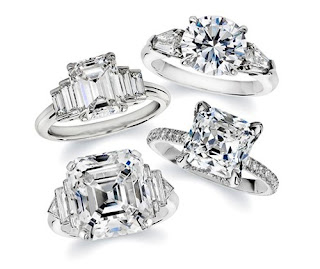Truly, diamonds are a girl's best friend. But how can any self-respecting girl adorn herself with such luxury without even understanding them? Thus the birth of 'Diamond Basics', a series of posts to help all ladies (and fellas out there looking for the perfect engagement ring) unearth the truth about these highly coveted precious stones.
So first of all, WHAT WHEN WHERE WHY HOW are diamonds formed?
 |
| Photo: Geology |
Diamonds are formed under tremendous heat and pressure. These conditions exist 150 km to 200 km beneath the earth's surface, where the temperatures are extremely high ranging from 900ºC to 1300ºC. For millions of years, carbon atoms deep in the earth's upper mantle have been exposed to these extreme conditions. As a result, these atoms combine their cubic molecular form and ultimately form diamond crystals. During volcanic eruptions, diamond crystals eventually make their way to the earth's surface through pipes and channels. These pipes or channels contain the magma from the volcano, which rises along with the diamonds and deposits them on the surface where they are later found and mined. -Buzzle
Diamonds can also be formed in subduction zones caused by plate tectonics, in extreme temperature and pressure during asteroid impacts, and in space found in meteorites.
This is how diamonds actually look like when they are just mined:
 |
| Photo: De Beers |
History
From myths about valleys of diamonds protected by snakes, to the production of millions of carats in rough diamonds each year, the history of diamonds is one of mystical power, beauty and commercial expertise.
Early History
The first recorded history of the diamond dates back some 3,000 years to India, where it is likely that diamonds were first valued for their ability to refract light. In those days, the diamond was used in two ways-for decorative purposes, and as a talisman to ward off evil or provide protection in battle.
The first recorded history of the diamond dates back some 3,000 years to India, where it is likely that diamonds were first valued for their ability to refract light. In those days, the diamond was used in two ways-for decorative purposes, and as a talisman to ward off evil or provide protection in battle.
The Dark Ages
The diamond was also used for some time as medical aid. One anecdote, written during the Dark Ages by St Hildegarde, relates how a diamond held in the hand while making a sign of the cross would heal wounds and cure illnesses. Diamonds were also ingested in the hope of curing sickness. During the early Middle Ages, Pope Clement unsuccessfully used this treatment in a bid to aid his recovery.
The diamond was also used for some time as medical aid. One anecdote, written during the Dark Ages by St Hildegarde, relates how a diamond held in the hand while making a sign of the cross would heal wounds and cure illnesses. Diamonds were also ingested in the hope of curing sickness. During the early Middle Ages, Pope Clement unsuccessfully used this treatment in a bid to aid his recovery.
The Middle Ages
During the Middle Ages more attention was paid to the worth of diamonds, rather than the mystical powers surrounding them. Due to the heightened public awareness of the value of diamonds, mine owners perpetuated myths that diamonds were poisonous. This was to prevent the mineworkers swallowing the diamonds in an attempt to smuggle them out of the mines.
During the Middle Ages more attention was paid to the worth of diamonds, rather than the mystical powers surrounding them. Due to the heightened public awareness of the value of diamonds, mine owners perpetuated myths that diamonds were poisonous. This was to prevent the mineworkers swallowing the diamonds in an attempt to smuggle them out of the mines.
The popularity of diamonds surged during the Middle Ages, with the discovery of many large and famous stones in India, such as the Koh-I-Noor and the Blue Hope. Today India maintains the foremost diamond polishing industry in the world.
 |
| Koh-I-Noor |
 |
| Hope Diamond |
As the Indian diamond supply dwindled, smaller finds occurred in Borneo and Brazil, but these were not sufficient to meet the ever-increasing demand for diamonds. The mid-nineteenth century discovery of diamonds near the Orange River in South Africa sparked the world's biggest diamond rush, and helped to satiate the world's increasing appetite for diamonds.
 |
| Africa diamond deposits |
Recent Times
During the mid-nineteenth century, diamonds were also being discovered in eastern Australia. However, it was not until late 1970's, after seven years of earnest searching, that Australia's alleged potential as a diamond producer was validated.
During the mid-nineteenth century, diamonds were also being discovered in eastern Australia. However, it was not until late 1970's, after seven years of earnest searching, that Australia's alleged potential as a diamond producer was validated.
On October 2nd 1979, geologists found the Argyle pipe near Lake Argyle: the richest diamond deposit in the world. Since then, Argyle has become the world's largest volume producer of diamonds, and alone is responsible for producing over a third of the world's diamonds every year.
 |
| Argyle Mine |
From the mine, diamonds are then taken to laboratories to be cut and polished - turning them to the beautiful stones we all know!
So the next time you look at a diamond, keep in mind that it is a very old (billions of years in fact!) piece of the earth!
Stay tuned for more diamond basics!




No comments:
Post a Comment
Note: Only a member of this blog may post a comment.